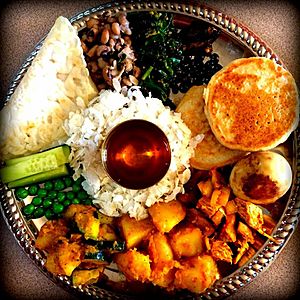Samay Baji facts for kids
Samay Baji (समय् बजि in Nepal Bhasa) is a very special and traditional meal from the Newar community in Nepal. It's a dish that has been enjoyed for many, many years, passed down through families. People in Nepal love it, and it has become a popular food for visitors too!
This unique meal is often served during important family gatherings, special events, and Newari festivals. It's usually the first food people eat at celebrations, religious events, and pujas (worship ceremonies). Samay Baji is also served during Sharada, which are special rituals to remember family members who have passed away. People enjoy it all year round because it's simple to make and can be kept for a long time. You'll often find Samay Baji at big Nepali festivals like Indra Jatra, Dashain, and Tihar (including Laxmi Puja and Bhai Tika). It's truly a part of almost every important event for the Newar people.
What's in Samay Baji?
A plate of Samay Baji is like a mini-feast, with many different tasty items served together! Each part adds its own flavor and texture. Here are some of the main things you'll find:
- Beaten Rice (Chyura): This is a flat, dry rice that's a main part of the dish.
- Wa: These are small, savory pancakes made from black gram or mung beans.
- Barbecued Buffalo Meat (Chhwela): Thin slices of buffalo meat, often marinated and grilled.
- Fried Boiled Egg: A simple, yet delicious addition.
- Black Soybeans (Bhatamaas): These add a nutty flavor and are often spiced.
- Spicy Potato Salad (Aalu-Wala): A tangy and spicy potato dish.
- Ginger (Palu): Finely cut ginger pieces, known for their fresh taste.
- Boiled Beans (Bodi ko Achar): Beans mixed with different spices.
- Green Leafy Vegetables (Saag): Cooked greens that add a healthy touch.
- Ayla: A special traditional drink from the Newar community.
Samay Baji also includes a type of achar (pickle), which is a mix of tangy and spicy vegetables. This often includes radish, carrots, onions, potatoes, and peas, all blended with a unique Nepali berry called lapsi. The exact ingredients can change from one family to another, as each household has its own special recipe! Some recipes might even include spices like asafoetida, Sichuan pepper, black salt, Himalayan pink salt, mustard, mustard oil, and fenugreek seeds with turmeric powder.
The Story Behind Samay Baji
Long ago, many Newars were farmers. Their lives were closely connected to the four seasons. In those days, there was no electricity or gas for cooking. People used wood fires, which took a lot of time and effort. Because of this, meals were usually cooked only twice a day: once in the morning and once in the evening.
Families would eat their main meal early in the morning, right after sunrise, before heading out to work in their fields. There wasn't really a "breakfast" as we know it today. Newar communities often lived close together, but their farms could be quite far away. Farmers would walk for an hour or more just to reach their fields! There weren't many places to rest or find shade along the way.
Since they ate so early, they needed snacks to keep them going until the evening meal. These snacks had to be easy to carry and didn't need to be reheated. That's how foods like beaten rice (Chyura), barbecued meat (Chhwela), black soybeans (Bhatamaas), ginger (Palu), and green leafy vegetables (Saag) became popular.
These snacks weren't just tasty; they were also chosen for their health benefits! For example, ginger (Palu) was known to help with stomach issues. Black soybeans (Bhatamaas) were thought to be good for the heart. Mustard oil, used in dishes like Chhwela, was believed to help keep food fresh, and green leafy vegetables (Saag) were a great source of vitamins. So, Samay Baji isn't just a meal; it's a clever and healthy way of eating that developed from the daily lives of the Newar people!


